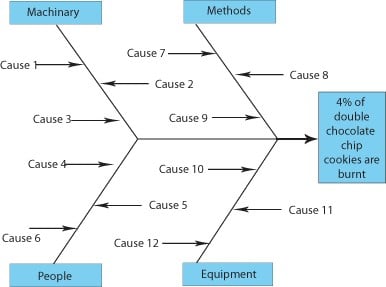Today, 40% of food in the United States is thrown away. Not only does this tremendous amount of waste hurt the environment, it also damages the bottom line for both food manufacturers and supermarkets. Supermarkets are changing the way they stock shelves to improve the situation, but even a just-in-time inventory strategy isn’t enough – that’s why food manufacturers’ methods must also change.
 By employing digital Kanban, food manufacturers can deliver a higher percentage of quality product to supermarkets while also gaining the agility to increase throughput, reduce cost, and improve the bottom line.
By employing digital Kanban, food manufacturers can deliver a higher percentage of quality product to supermarkets while also gaining the agility to increase throughput, reduce cost, and improve the bottom line.
What is Digital Kanban?
Kanban traditionally used physical, colored cards to signal the timing of the next step in a manufacturing process. Cards appeared based on a “pull” system wherein items were pulled as needed from a warehouse or supplier (preferably a supplier) as a result of ingredients/materials usage and replenishment needs. This reduced overstocking and spoilage because the “pull” occurred as a result of real customer demand.
Digital Kanban improves traditional Kanban by transforming physical cards into electronic messages that originate from the ERP and/or e-Kanban system. By digitizing Kanban, signals occur in real time, and more departments can join the process. For example, when a replenishment card for fresh tomatoes appears, the ERP system automatically creates and routes the associated purchase order to keep the Kanban process moving faster.
How It Works
Kanban doesn’t simply react to customer orders – it reacts to the consumption of manufacturing inputs. For every bin of an individual manufacturing input (e.g., cherries, gum, etc.) on the manufacturing shop floor, there are two corresponding bins. One bin is full and waiting in your warehouse; the other is full/committed at your supplier. When the floor bin reaches empty, the ERP system signals the warehouse to send the full bin to manufacturing. At the same time, the system requests your supplier to send a new bin to your warehouse.
Your bin sizes are based on forecast demand levels and can absorb unusually large orders without requiring rush orders for new inputs. That’s because your warehouse bin holds the amount needed beyond expected current demand while the supplier bin serves as a cushion for exceptional demand occurrences. This prevents emergency ordering that costs more in terms of shipping and expediting fees. Of course, to ensure solid Kanban execution, you need to form close relationships with suppliers who will accommodate your request to always have a bin available for you.
Sensors Can Make Digital Kanban Even Better
Sensors can act as another source of Kanban signals in modern warehouses. By using sensor technology on your warehoused items, you can receive alerts telling you when to use a food or ingredient, or you might receive inputs from intelligent containers that can report temperature abnormalities. This allows the ERP system to send a Kanban signal regarding the need to use those items soon and even reprioritize production schedules. While this is an exception to Kanban's normal "pull" system, it allows you to minimize spoilage and sell salvaged products with special incentives - 70% of your regular price is better than 0%.
If you consider the opportunities sensors and RFID present for tracking the combination of product location and quality, the justification for digital Kanban seems simple; specifically, digital Kanban provides:
- Higher product quality
- Lower inventory and spoilage costs
- Increased manufacturing throughput
- Improved customer relations
How to Get Started with Digital Kanban
At MTC, we help food and beverage manufacturers leverage ERP and lean to improve top-line revenue and the bottom line. Contact us today to discuss your lean goals.










Leave a comment